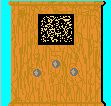
| Hawes Mechanical Television Archive |
|
|
|
Build a Mechanical TV Monitor, Part 1 |
|
|---|---|---|
Simple display driver for mechanical television
Requirements. To operate, my LED driver requires a mechanical scanner that you can synchronize with the program. Most mechanical TV (MTV) hobbyists use 32-line, 12.5 frames-per-second (fps) scanners. The scanner could be a disc or drum type. Enclose the LEDs in a lightbox with a frosted-glass, translucent window. Opposite the window and at least two inches back, mount the LED matrix. The amplifier circuit requires a power supply and a source of programs. I suggest the CDs on this page... NBTVA program discs. The NBTVA discs are for use with a 32-line, 12.5 fps television scanner. Note: I haven't optimized this LED driver for the NBTVA discs. This driver design doesn't follow NBTVA specs, or specs of any other organization. HistoryDaven was a Newark, New Jersey electronics manufacturer. This Daven advertisement has a photo of the Daven amplifier, plus many related Daven parts. Daven's amplifier was one of the early commercial TV amplifiers. In December 1928, Popular Mechanics ran a construction article about the amplifier. This article shows Daven's amplifier in use with the company's triple-spiral scanning disc. This disc could reproduce telecasts on the 24, 36 and 48-line television standards. A New York viewer of the day would need all three standards! Better tubes. Just a few years later, screen grid tubes (tetrodes) began to appear in the input stages of TV preamplifiers. The newer tubes could develop far more voltage gain than could Daven's MU-20 triodes. In fact, the amplification factor for a Daven MU-20 is only 20. Note that Daven includes the amplification factor (mu) in the tube name. (Nice idea!) Amplification factor is an ideal, rather than a real-world gain figure. In typical circuits, voltage gain would be in the single digits. Later tubes could increase this gain by 10 times or more per stage. More capable tubes also drove the TV display. These superior tubes were power triodes or tetrodes. For example, tubes such as type 45, 50 or 10. These tubes could supply the load with higher voltage than could Daven's MU-6 triode. New disc standards. Other changes were afoot, too. In 1928, the RMA approved new regional TV standards. Among these were the 45-line, triply-interlaced, 15-fps pictures that became the norm in the Midwest. Ulises Sanabria of Western Television invented this standard. On the East Coast, the standard soon became 60 lines sequential at 20 fps. Dr. Frank Conrad of Westinghouse designed this standard. RCA, Jenkins and CBS soon adopted Conrad's standard. Unfortunately for Daven, its tri-standard disc didn't support these new standards. A disc retrofit would have allowed Popular Mechanics' scanner to bring in 45-line pictures. Sixty-line reception was another matter. A 60-line aperture disc is some 31 inches across. It just wouldn't have fit into Popular Mechanics' cabinet. The cabinet design only allows for discs up to about 24 inches across. Just as today, obsolescence comes quickly for cutting-edge technology. LED driver specsMy circuit provides the entire video electronics and the video display for a mechanical television receiver. See the block diagram above. Build my circuit, and you'll have the equivalent of diagram blocks 2, 3 and 4.
My inspiration: 1928 video amp and driver by Daven Where I part with DavenMy LED driver follows the Daven amplifier's use of three amplifying stages. Yet I've introduced several changes to the original design. Here's a summary of these changes...
Go to Page: 1 2 3 4 Next
|
MECHANICAL TELEVISION LINKS
|
|
|||
|
Copyright © 2002 by James T. Hawes. All rights reserved.
•URL: http://www.hawestv.com/mtv_page/mtv_page.htm
•Webmaster: James T. Hawes
|
|||